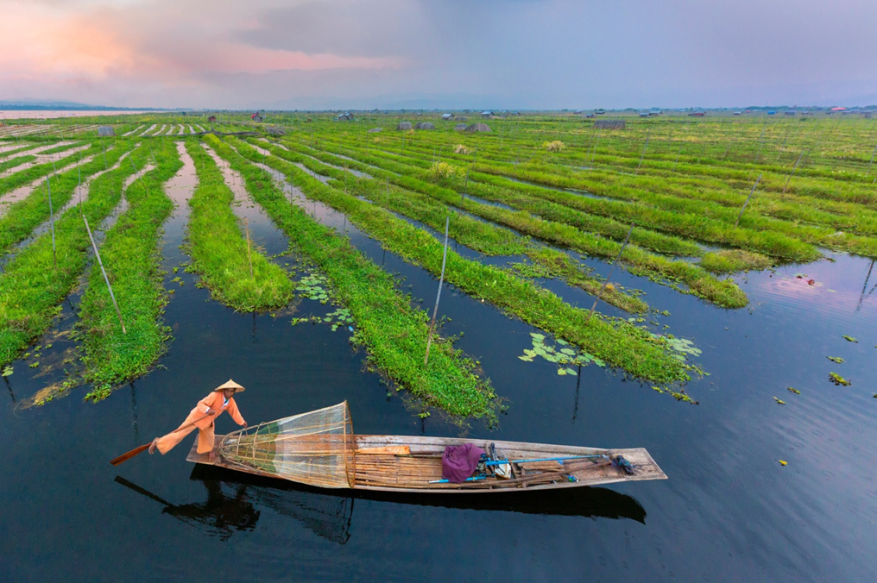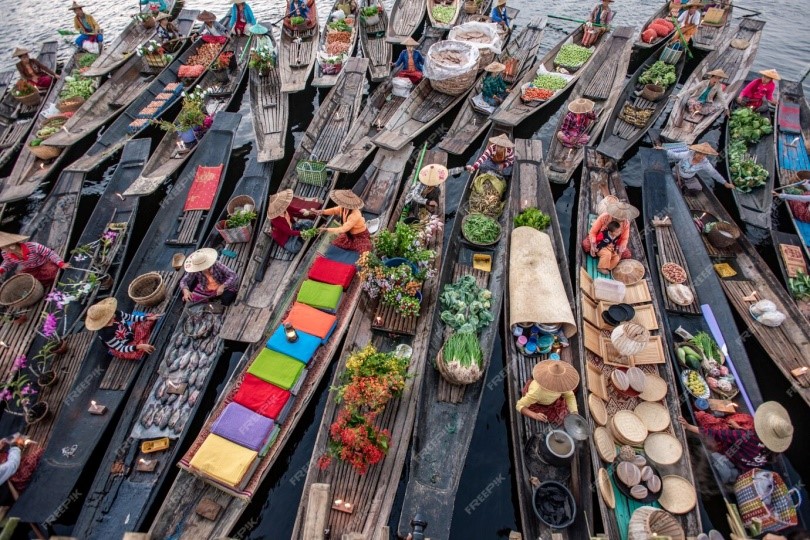The Intha people, with a population of around 200,000 residing around the Inle Lake have Cultural Heritage tied to the body of water that dates back to the 14th century. Having fled from ruling powers in Southern Myanmar, the Intha people settled on the Inle Lake, resulting in a Cultural Heritage that revolves around life on these boundaries.
From distinctive poetry, called taiktay, the lansi, lunsi and ozigyi dances as well as a unique culinary and agricultural culture, the Intha people have certainly cultivated a way of life that is without comparison.

The Floating Gardens of Inle Lake
The floating gardens of Inle Lake were born out of a need for more agricultural land and eventually became an efficient method of crop production. Farmers gather weeds from the bottom of the lake to turn into floating garden beds before anchoring them with long bamboo poles. The result is a mystic wonderland of floating vegetation corridors that occupies much of the lake, for at least six months of the year (with the other six months dedicated to fishing). The floating gardens have brought about economic benefit in numerous ways – tomatoes can be grown year-round, unlike in other areas of Myanmar, and therefore excess production has long been sold by the Intha people. Further to this, the unique sights of the floating gardens attract an estimated 20,000 foreign tourists yearly and an estimated one million local tourists.

Visitors are able to experience a traditional way of life at the Inle Lakes and a culture that had developed out of necessity but has persevered through the resilience and adaptability of its people. The unique stilt houses made of bamboo allow for visitors to experience life above water. Visitors can also prepare for a unique culinary experience, with a uniquely-prepared Say-khar hin (bitter soup) made from the ingredients of the floating gardens. Although Myanmar does not currently have a sui generis geographical indication protection system, the Intha people and their unique culinary dishes would have several products up for possible registration.
The Intha people also drink a unique green tea that is seasoned with salt that is unique to the region.
Cultural Heritage to Protect the Future of Inle Lake
Modern ways of life have unfortunately interfered with the sustainability of Inle Lake. While the floating gardens have proven to be an extremely efficient and successful method of crop production, fertilizers and pesticides have increased their efficiency exponentially in recent years which has led to problems. The increased surface area of the floating farms due to the use of modern pesticides and fertilizers which has in turn decreased the surface area of the lake by a significant amount.
Climate change has also played a role in the reduced surface area of the lake with a decreasing monsoon period over the past 30 years also contributing to the decreased lake surface area. Certain areas of the lake, including sacred Buddhist pilgrimage sites are often inaccessible during certain times of the year due to these changes.
Sustainable tourism, and tourism that focuses on the intangible cultural heritage of Inle Lake and the Intha people could be the key to long-term health and success of Inle Lake as a tourist destination. Increased tourist revenue would reduce the need for the indigenous Intha people to rely on a great number of floating gardens and would reduce the need for fertilizer and pesticides, the runoff of which also affects the ability to fish the waters.

While tourism has often focused on the floating gardens and the natural beauty, tapping into the cultural heritage of the Inthe people and their unique traditions which have merged with Buddhism would allow for new sources of revenue and for these traditions to continue to exist for future generations. Intellectual property through the promotion of traditional knowledge and cultural expressions provides a pathway for the sustainability of Inle Lake and will allow for the area’s most important resource, the Intha people, to truly shine.






